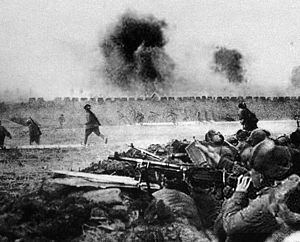~150,000 250,000 Dates 7 Oct 1948 – 15 Oct 1948 | 20,000 deaths, 80,000 captured 24,000 | |
 | ||
Result Fall of Jinzhou for the Nationalist Government Similar Chinese Communist Revolution, Chinese Civil War, Campaign to Defend Siping, Linjiang Campaign, Siege of Changchun | ||
Battle of jinzhou
Battle of Jinzhou (simplified Chinese: 锦州之战; traditional Chinese: 錦州之戰; pinyin: Jînzhou Zhīzhàn) was a battle between the Communist People's Liberation Army (PLA) and the Kuomintang's National Revolutionary Army (NRA) during the Chinese Civil War. It was one of the most decisive battles during the war in Manchuria; literally an epitome of the Liaoshen Campaign.
Contents
Background
Jinzhou is where the main route from central China through Shanhai Pass enters Manchuria, and is a key strategic point. The fall of Jinzhou to the Communists would allow the Communist to drive into the North China Plain. Mao Zedong addressed the importance of capturing Jinzhou in a telegram to the Communist commanders in the Northeast, saying that the key to the success of the entire Liaoshen Campaign is "to strive to capture Jinzhou in one week."
Outside the city
To attack Jinzhou, it was necessary for the PLA to clear away the Nationalist positions in the outskirts of Jinzhou. Between October 8 to October 13, the Communists captured all the Nationalist strongholds outside Jinzhou, which set up the final assault on October 14. In the meantime, in the Battle of Tashan nine PLA divisions defeated eleven NRA divisions attempting to reinforce Jinzhou.
Final assault
The PLA massed 900 artillery pieces, and launched the final assault on Jinzhou on October 14, 1948. The entire defensive line of Jinzhou was broken through soon after. Nationalist resistance ended the next day on October 15.
